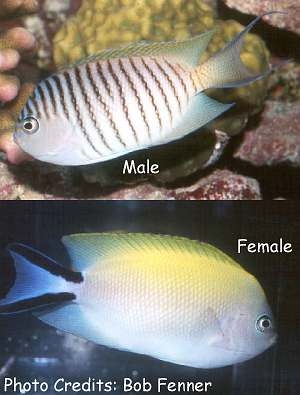
By Bob Goemans

Likely Reef Tank Suitable
Likely Fish-Only Tank Suitable
Range: Indo-West Pacific Ocean: Indonesia to Fiji, north to southern Japan, and south to New Caledonia.
Size: 7 inches (18 cm)
Natural Environment: Inhabits fore-reef drop-offs rich in coral and sponge growths at depths of 50 to 250 feet (15 – 75 m) and is an open water plankton feeder.
General Husbandry: This very hardy species is often available in the trade and makes for a colorful and peaceful addition to both fish-only and reef aquariums. The male is quite different in coloration than the female (sexual dimorphism), having a bluish white body with numerous reddish black vertical bans, with its dorsal, caudal and anal fins containing yellow spots. The tail, which is pale yellow with blue edging, has long streamers. As for the female, its body top half is yellow, while its lower area is a bluish white, and its lunate caudal fin is bluish with a black band on the upper and lower edges. Both have a tail that tapers into the body, resulting in what can be called a swallowtail appearance. In fact, those in this genus are sometimes called Swallowtail Angelfish.
Best maintained in moderately lit aquariums since they are usually collected in somewhat deep water and are often found in caves, and those having excellent water flows and lots of wide-open swimming areas. As to diet, they should be offered at a minimum several daily feedings so as to quickly acclimate it to its surroundings. Like many others in this genus, their captive diet should consist of a wide variety of meaty foods including fortified brine shrimp, mysis and angelfish food preparations, and continued to be offered several times daily after its acclimated to its surroundings. Some flake foods, especially those containing Spirulina should also be offered occasionally, as algae, especially Spirulina is a healthy addition to all that consume it.
Depending upon its tankmates, it can be quite shy when first entering the aquarium, and may hide in caves and crevices. But as time passes, will become more outgoing. Those in this genus, as those in the genus Apolemichthys and Chaetodontoplus, are almost always very good tankmates and considered one of the least aggressive in the family. Keep in mind males will fight among themselves, so the limit is one per aquarium, whereas multiple females can be maintained, and all can be maintained with other genus angelfish.
Taxonomy:
Order: Perciformes
Suborder: Percoidei
Family: Pomacanthidae
Genus: Genicanthus
FYI: Keeping more than one genus of angelfishes in the same aquarium is possible, yet depends upon several aspects. The following suggested circumstances are just that, possibilities that when heeded and adjusted to actual aquarium conditions ‘may’ make multiple angelfish collections feasible.
Aquarium size – the larger the better.
Other species from the same genus should not be in the same aquarium.
The smallest and most docile genus species should be the first introduced with the largest and most malicious the last to be added.
Do not place similar coloration species in the same aquarium.
Those already in the aquarium should be well fed before adding a newcomer.
Have sufficient hiding places/rocky caves.
Keep in mind all angels have cheekspines at the edge of their gill cover; therefore use caution when handling and also avoid using a net to capture it, as it may become stuck or tangled in the net and become damaged when removed.
Experience Level: Intermediate
Temperament: Peaceful
Diet: Planktivore
Acclimation Time: 30 minutes+
Aquarium Environment: Fish-only and reef aquariums
Reef Safe: Yes
Minimum Tank Size: 125 gallons
Temperature Range: 73 - 82°F (23 – 27°C)
Specific Gravity: 1.020 - 1.026
pH: 8.0 - 8.5
